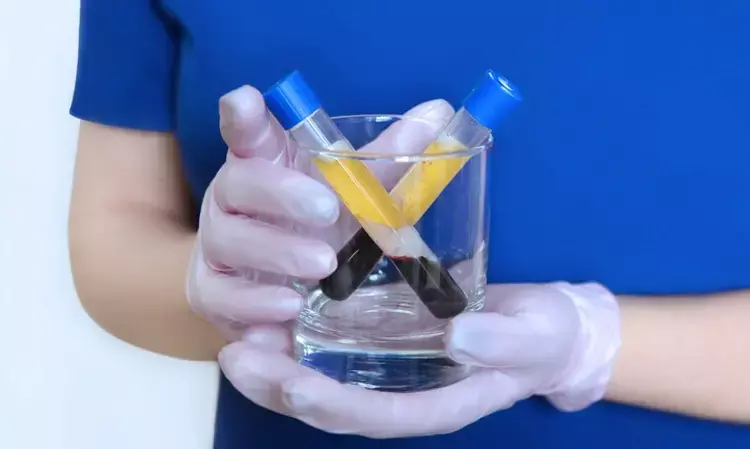- Home
- Medical news & Guidelines
- Anesthesiology
- Cardiology and CTVS
- Critical Care
- Dentistry
- Dermatology
- Diabetes and Endocrinology
- ENT
- Gastroenterology
- Medicine
- Nephrology
- Neurology
- Obstretics-Gynaecology
- Oncology
- Ophthalmology
- Orthopaedics
- Pediatrics-Neonatology
- Psychiatry
- Pulmonology
- Radiology
- Surgery
- Urology
- Laboratory Medicine
- Diet
- Nursing
- Paramedical
- Physiotherapy
- Health news
- Fact Check
- Bone Health Fact Check
- Brain Health Fact Check
- Cancer Related Fact Check
- Child Care Fact Check
- Dental and oral health fact check
- Diabetes and metabolic health fact check
- Diet and Nutrition Fact Check
- Eye and ENT Care Fact Check
- Fitness fact check
- Gut health fact check
- Heart health fact check
- Kidney health fact check
- Medical education fact check
- Men's health fact check
- Respiratory fact check
- Skin and hair care fact check
- Vaccine and Immunization fact check
- Women's health fact check
- AYUSH
- State News
- Andaman and Nicobar Islands
- Andhra Pradesh
- Arunachal Pradesh
- Assam
- Bihar
- Chandigarh
- Chattisgarh
- Dadra and Nagar Haveli
- Daman and Diu
- Delhi
- Goa
- Gujarat
- Haryana
- Himachal Pradesh
- Jammu & Kashmir
- Jharkhand
- Karnataka
- Kerala
- Ladakh
- Lakshadweep
- Madhya Pradesh
- Maharashtra
- Manipur
- Meghalaya
- Mizoram
- Nagaland
- Odisha
- Puducherry
- Punjab
- Rajasthan
- Sikkim
- Tamil Nadu
- Telangana
- Tripura
- Uttar Pradesh
- Uttrakhand
- West Bengal
- Medical Education
- Industry
Ambroxol therapy improve Symptoms in Gaucher disease patients: JAMA

Ambroxol proved safe to use over the long term and was related with patient improvement in Gaucher disease (GD) patients, says an article published in the Journal of American Medical Association.
In 2009, it was discovered that ambroxol improved the stability and lingering activity of a number of misfolded glucocerebrosidase variants. As a result, this study was carried out by Xia Zhan and colleagues to evaluate the hematologic and visceral results, biomarker changes, and safety of ambroxol medication for patients with Gaucher disease (GD) who were not receiving disease-specific treatment.
From May 6, 2015, to November 9, 2022, patients with GD who could not afford enzyme replacement treatment were recruited and administered oral ambroxol at the Shanghai, China-based Xinhua Hospital, which is connected with Shanghai Jiao Tong University School of Medicine. A total of 32 GD patients were included. 28 of the patients underwent follow-up for a period of time greater than six months; 4 were disqualified owing to loss of follow-up. Data analysis was carried out between May 2015 and November 2022. In a genetic metabolism centre, ambroxol-treated GD patients were monitored. Hematologic parameters, liver and spleen volumes, and biomarkers of chitotriosidase activity and glucosylsphingosine level were assessed at baseline and at various intervals throughout the ambroxol therapy.
The key findings of this study were:
1. Ambroxol was administered to a total of 28 patients for a mean (SD) of 2.6 (1.7) years.
2. Clinical response was seen in the remaining 26 individuals, but two patients with severe symptoms at baseline had worsening of hematologic parameters and biomarkers and were labelled nonresponders.
3. The mean (SD) haemoglobin concentration increased from 10.4 (1.7) to 11.9 (1.7) g/dL after 2.6 years of ambroxol therapy, while the mean (SD) platelet count increased from 69 (25) to 78 (30) 103/L.
4. The mean (SD) liver volume fell from 1.90 (0.44) to 1.50 (0.53) MN, while the mean (SD) spleen volume decreased from 17.47 (7.18) to 12.31 (4.71) multiples of normal (MN).
5. The biomarker median percentage changes from baseline were 34.1% for glucosylsphingosine level and 43.1% for chitotriosidase activity.
6. According to the age at which they began treatment, patients were divided into subgroups.
7. Those who started treatment earlier saw more rapid improvements: hemoglobin concentration increased by 16.5%, platelet count increased by 12.0%, whereas chitotriosidase activity decreased by 64.0% and glucosylsphingosine level decreased by 47.3%. There were three minor and brief adverse effects among the 28 individuals.
Reference:
Zhan, X., Zhang, H., Maegawa, G. H. B., Wang, Y., Gao, X., Wang, D., & Li, J. (2023). Use of Ambroxol as Therapy for Gaucher Disease. In JAMA Network Open (Vol. 6, Issue 6, p. e2319364). American Medical Association (AMA). https://doi.org/10.1001/jamanetworkopen.2023.19364
Neuroscience Masters graduate
Jacinthlyn Sylvia, a Neuroscience Master's graduate from Chennai has worked extensively in deciphering the neurobiology of cognition and motor control in aging. She also has spread-out exposure to Neurosurgery from her Bachelor’s. She is currently involved in active Neuro-Oncology research. She is an upcoming neuroscientist with a fiery passion for writing. Her news cover at Medical Dialogues feature recent discoveries and updates from the healthcare and biomedical research fields. She can be reached at editorial@medicaldialogues.in
Dr Kamal Kant Kohli-MBBS, DTCD- a chest specialist with more than 30 years of practice and a flair for writing clinical articles, Dr Kamal Kant Kohli joined Medical Dialogues as a Chief Editor of Medical News. Besides writing articles, as an editor, he proofreads and verifies all the medical content published on Medical Dialogues including those coming from journals, studies,medical conferences,guidelines etc. Email: drkohli@medicaldialogues.in. Contact no. 011-43720751


